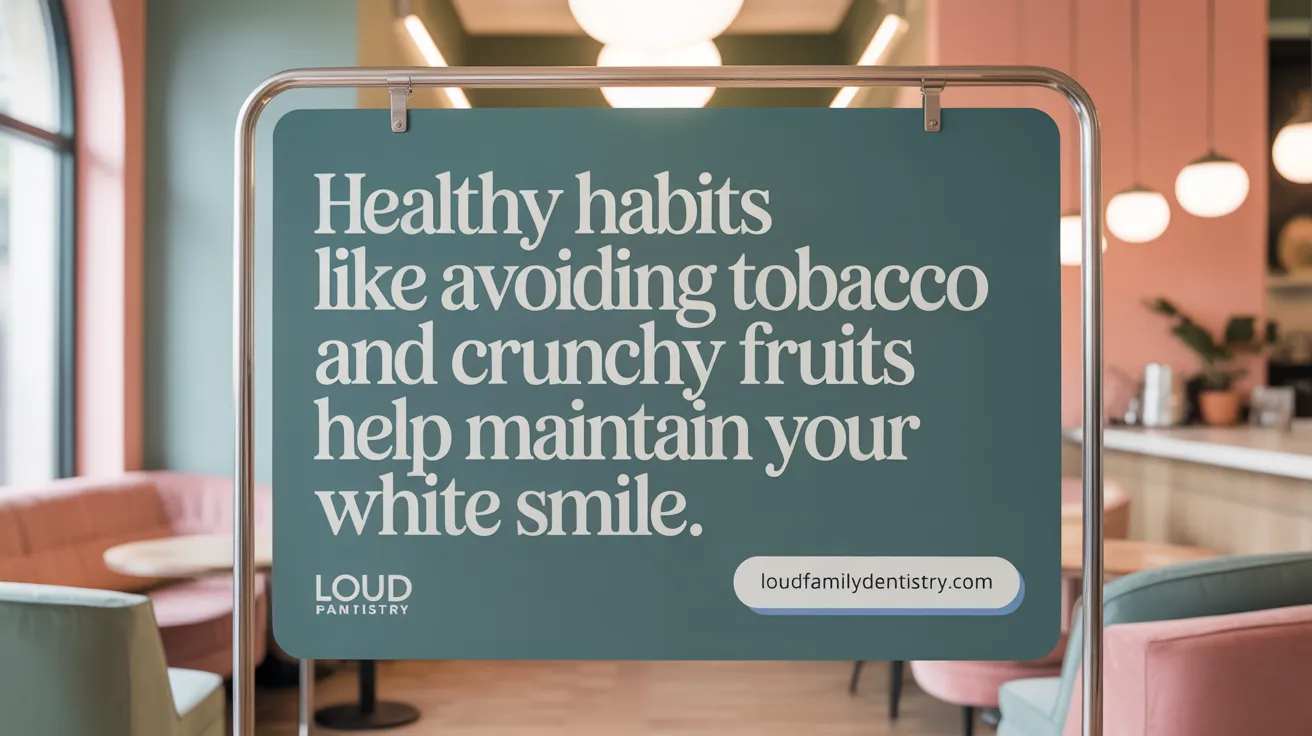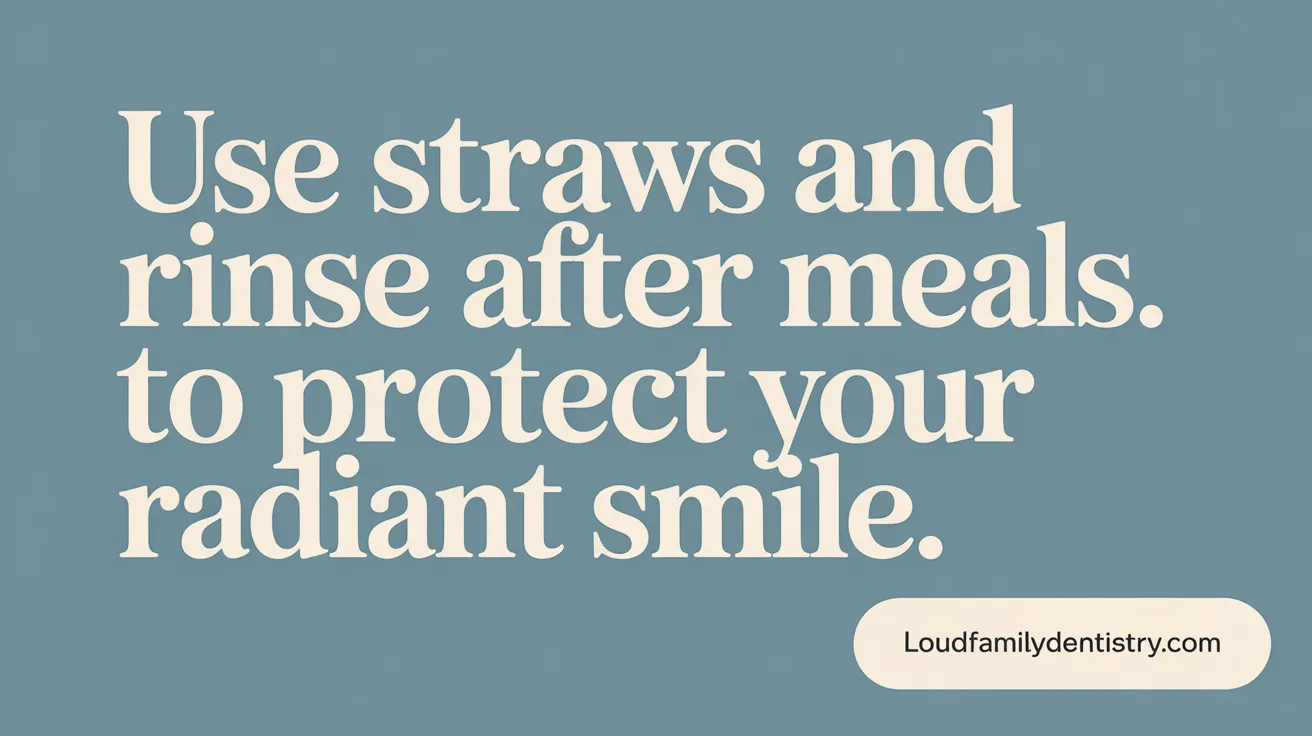The Importance of Proper Post-Whitening Care
Achieving a bright, white smile through teeth whitening treatments can be truly transformative. However, maintaining those dazzling results requires knowledge and commitment to specific oral care routines and lifestyle choices after the procedure. This article explores key practices, dietary considerations, natural habits, professional advice, and common pitfalls to avoid, ensuring your smile stays luminous for months to come.
Foundations of Post-Whitening Oral Care Routines

What are the proper oral care routines and habits to follow after teeth whitening?
Immediately after whitening, your teeth are more sensitive and porous, which means they can pick up stains more easily. During the first 48 hours, it’s crucial to avoid foods and drinks that stain, such as coffee, tea, red wine, berries, soy sauce, tomato sauce, citrus fruits, and dark sodas. Drinking through a straw and rinsing your mouth with water after consuming these can help protect your teeth.
Gently brushing your teeth twice daily with a soft-bristled toothbrush is advisable. Use a non-abrasive, whitening toothpaste that helps remove surface stains while being gentle on enamel. Flossing daily helps keep your gums healthy and removes food particles that could cause discoloration. Additionally, using an alcohol-free whitening mouthwash can aid in maintaining your whitening results.
It’s also recommended to avoid extreme hot or cold foods that could cause sensitivity. If you experience discomfort, using a toothpaste formulated for sensitive teeth can alleviate pain. During this initial period, maintaining good hydration by drinking plenty of water helps wash away staining agents and keeps your mouth moist.
Long-term, consistent oral hygiene routines are essential. Regular dental visits for professional cleanings every six to twelve months can remove tartar and plaque buildup, further supporting the brightness of your smile. Moreover, limiting foods and drinks that can stain teeth will help prolong your whitening results, ensuring a sustained, radiant smile.
Dietary Guidelines to Preserve Whitening Results
Which dietary recommendations and foods should be avoided after whitening treatments to preserve brightness?
After a teeth whitening procedure, following specific dietary guidelines can significantly extend the results. During the first 48 hours, it's crucial to avoid foods and drinks that can stain the teeth. These include coffee, tea, red wine, dark berries, soy sauce, tomato sauces, and anything with artificial dyes or strong pigmentation.
It is also recommended to steer clear of acidic foods like citrus fruits, vinegar, and sodas, as they can soften the enamel temporarily and make teeth more susceptible to staining. Consuming these items can diminish the brightness achieved during whitening.
Instead, opt for a "white diet" consisting of light-colored, non-staining foods. These include plain yogurt, eggs, chicken, fish, milk, bananas, cauliflower, white rice, peeled potatoes, and soft cheeses. Such foods are gentle on your teeth, help maintain their whiteness, and avoid adding new stains.
Additional tips to support your whitening results include avoiding smoking and using a straw when drinking colored beverages. Rinsing your mouth with water after consuming stain-causing foods or drinks helps wash away residues that can cause discoloration.
Maintaining rigorous oral hygiene—brushing with a soft toothbrush, flossing daily, and using an alcohol-free whitening mouthwash—further protects your teeth from staining. Waiting at least 30 minutes before brushing after consuming acidic or pigmented foods reduces the risk of enamel erosion.
Implementing these habits, along with regular dental checkups and touch-up whitening treatments as recommended, can help you enjoy the bright smile for a longer period.
Natural and Lifestyle Habits to Extend Whitening Effects

What natural and lifestyle practices can help prolong the effects of teeth whitening?
Maintaining a brilliant white smile involves adopting simple yet effective habits that support the longevity of whitening treatments. Regular oral hygiene is fundamental; brushing twice daily with a fluoride-based, non-abrasive toothpaste, flossing daily, and visiting the dentist every six to twelve months for professional cleanings help remove surface stains and plaque.
Incorporating crunchy fruits and vegetables such as apples, carrots, and celery into your diet can be particularly beneficial. These foods act as natural scrubbers, physically removing stains from the enamel surface. They also stimulate saliva production, which helps neutralize acids and protect your teeth from decay and staining.
Hydration plays a crucial role. Drinking plenty of water not only washes away food particles but also keeps your mouth moist, which is vital for neutralizing acids and maintaining enamel health. Rinsing with water after consuming staining foods like coffee, tea, berries, or tomato sauce further reduces the risk of discoloration.
Avoiding tobacco products is essential, as smoking and tobacco use are major causes of deep stains. Quitting tobacco not only improves overall health but also preserves the whiteness of your teeth.
Natural methods such as using a soft toothbrush and gentle, fluoride toothpaste help prevent sensitivity while cleaning effectively. Additionally, visiting your dentist regularly for professional cleanings helps remove tartar and surface stains, supporting your whitening efforts.
By combining excellent oral hygiene, a balanced diet rich in crunchy, water-rich foods, and lifestyle choices like avoiding tobacco, you can significantly extend the bright, white appearance achieved through whitening treatments. Remember, occasional touch-ups by your dentist may still be necessary to maintain your perfect smile.
Professional Recommendations for Long-Term Whitening Success

Why are regular dental checkups and professional cleanings important?
Maintaining a bright smile goes beyond just whitening treatments. Regular dental visits, ideally every six to twelve months, help remove plaque and tartar that can cause staining and discoloration. They also provide an opportunity for your dentist to evaluate your whitening results and recommend personalized touch-up treatments if needed. These professional cleanings help keep your teeth free of surface stains, ensuring your whitening efforts last longer.
How often should I consider whitening touch-up treatments?
Over time, teeth may gradually regain their original color due to exposure to stain-causing foods and drinks. To maintain a consistently bright smile, many dentists suggest touch-up whitening treatments every six to twelve months. These procedures can be done professionally or at home with dentist-supervised products. Regular follow-ups help keep discoloration at bay and preserve your investment in whitening.
What advice is there on using whitening products and seeking dental supervision?
Using at-home whitening trays or whitening toothpaste can help maintain your results, but it’s important to do so under dental supervision. Dentists can recommend the right products and provide instructions to minimize tooth sensitivity. Utilizing custom-fitted trays ensures an even application and reduces the risk of overexposure to bleaching agents. Always follow your dentist’s advice to avoid damaging your enamel or causing sensitivity.
Which strategies can help avoid enamel damage?
Post-whitening, enamel becomes more porous and susceptible to staining and sensitivity. To protect your teeth, avoid stain-causing foods and drinks such as coffee, tea, red wine, berries, and dark sauces in the initial 48 hours. Using a soft toothbrush and gentle toothpaste, especially desensitizing formulas, helps prevent abrasion. Drinking through a straw, rinsing with water after consuming staining foods, and waiting at least 30 minutes before brushing further protect enamel. Regular use of fluoride toothpaste also strengthens enamel.
What are the benefits of using custom-fitted trays and professional guidance?
Custom trays created by your dentist ensure a snug fit, which promotes uniform whitening and minimizes gum irritation. Professional guidance during whitening treatments helps to control the application process, ensuring safety and effectiveness. Dentists can tailor the strength and duration of bleaching agents, adjusting treatments based on your sensitivity levels and whitening goals. This personalized care supports long-term results and helps prevent inadvertent damage.
| Aspect | Recommendations | Additional Benefits |
|---|---|---|
| Regular Checkups | Every 6-12 months | Plaque removal, stain assessment |
| Whitening Touch-Ups | Semiannual or annual | Prolonged brightness, stain prevention |
| At-Home Products | Dentist-guided whitening trays, mild toothpaste | Safer application, minimized sensitivity |
| Lifestyle Habits | Avoid tobacco, limit stain foods | Long-lasting white smile |
| Oral Hygiene | Brush twice daily, floss, use fluoride | Enamel protection, stain removal |
| Hydration | Drink water regularly | Washes away residues, maintains pH |
Applying these professional tips can ensure your teeth stay bright and healthy for years to come. Regular maintenance, cautious food choices, and personalized dental care play crucial roles in extending the lifespan of your whitening results.
Common Pitfalls and Mistakes to Avoid for Lasting Whitening

What common mistakes should be avoided to ensure teeth whitening results last longer?
Maintaining a bright smile after whitening involves more than the procedure itself. One of the most important steps is being mindful of what you consume immediately afterward. For the first 48 hours, it is crucial to avoid foods and beverages that can stain teeth, such as coffee, tea, red wine, berries, soy sauce, tomato sauce, citrus fruits, and dark sodas. These items contain pigments and acids that can seep into porous enamel and cause discoloration.
Good oral hygiene plays a significant role in preserving whitening results. Brushing twice daily with a gentle, non-abrasive whitening toothpaste, flossing, and regular dental checkups help eliminate surface stains and plaque. Rinsing the mouth after consuming stain-causing foods also minimizes their impact.
Overusing whitening products or not following the recommended guidelines can be harmful. Excessive use may lead to enamel erosion or increased tooth sensitivity. It's best to adhere to your dentist’s instructions and opt for professional touch-ups every six to twelve months if needed.
Another common mistake is neglecting professional advice. Skipping regular dental visits means missing opportunities for professional cleaning and early intervention for any issues that may reduce the longevity of your whitening. Long-term habits like tobacco smoking also cause deep stains and should be avoided for lasting results.
In summary, avoiding stain-causing foods and drinks right after whitening, practicing good oral hygiene, limiting the use of whitening products without guidance, and quitting tobacco use are essential steps for maintaining a bright, white smile over time.
Managing Post-Whitening Sensitivity and Enamel Care
Understanding enamel porosity after whitening
After teeth whitening procedures, your tooth enamel becomes temporarily more porous. This increased porosity allows for better stain removal but also makes teeth more sensitive and susceptible to staining from foods and drinks. Typically, this heightened state lasts about 24 to 48 hours. During this period, enamel can absorb pigments more easily, which is why avoiding stain-causing foods and beverages is essential.
Use of desensitizing toothpaste
To alleviate sensitivity after whitening, many patients find relief using desensitizing toothpaste. These special toothpastes contain ingredients like potassium nitrate or fluoride that help soothe the nerve endings inside teeth. Usually, the sensitivity lasts between one to three days but can be minimized with consistent use.
Proper brushing timing and techniques
It’s important to wait at least 30 minutes after whitening before brushing your teeth. This allows any temporary enamel softening to subside. When you do brush, opt for a soft-bristled toothbrush and a gentle, non-abrasive whitening toothpaste. Gentle brushing helps remove plaque without irritating the enamel further.
Avoiding acidic or extreme temperature foods
In the initial days following whitening, it’s best to steer clear of acidic foods like citrus fruits, tomatoes, and vinegar. These can soften enamel temporarily and increase sensitivity. Additionally, very hot or cold foods and drinks should be avoided as they can trigger discomfort. Sticking to lukewarm or room temperature options helps protect your teeth during this delicate time.
Alleviating discomfort in the first days post-treatment
Most people experience mild tooth sensitivity in the first few days after whitening, but this usually diminishes quickly. Using anti-sensitivity toothpaste and avoiding stain-rich foods can make this period more comfortable. If discomfort persists or worsens, consulting your dentist is recommended. They can provide personalized advice and may suggest additional treatments to manage sensitivity effectively.
Supplementary Practices to Support Whitening Longevity

How can the use of straws help preserve whitening results?
Using a straw when drinking stain-causing beverages like coffee, tea, or red wine can reduce contact with your teeth. This minimizes pigmentation and keeps your teeth brighter longer.
Why is rinsing mouth after consuming pigmented foods or drinks important?
Rinsing your mouth with water immediately after eating or drinking dark-colored foods helps wash away pigments and acids. This simple step prevents staining and protects enamel from erosion.
Is choosing clear or white mouthwash beneficial?
Colored mouthwashes with artificial dyes can stain teeth over time. Opting for clear or white mouthwash helps maintain the whiteness of teeth without adding to discoloration.
How does maintaining a balanced diet support teeth whitening?
Eating foods rich in calcium, vitamin D, and phosphorus strengthens enamel. Stronger enamel resists staining and erosion, aiding in the maintenance of a bright, healthy smile.
What role do baking soda and crunchy produce play?
Incorporating baking soda once a week can gently polish away surface stains due to its mild abrasive qualities. Crunchy fruits and vegetables like apples, carrots, and celery stimulate saliva production, which naturally cleans teeth and helps remove surface stains.
Sustaining Your Radiant Smile Over Time
Maintaining a bright, whitened smile extends beyond the treatment chair. By adopting thorough oral care routines, making informed dietary choices, embracing natural habits, heeding professional advice, and avoiding common mistakes, you can enjoy prolonged whitening effects. Regular dental visits paired with mindful lifestyle selections create the foundation for long-lasting radiance. Remember, patience and consistency in care not only preserve your smile but also promote overall oral health, ensuring your confidence shines as brightly as your teeth.
References
- Tips to Keep Your Bright Smile After a Teeth Whitening ...
- Aftercare Tips for Professional Teeth Whitening
- How to Maintain a Bright Smile After Teeth Whitening and ...
- Post-Whitening Care Tips for a Lasting Smile
- Post-Whitening Tips for a Bright, Lasting Smile
- Aftercare Tips for Long-Lasting Teeth Whitening Results
- Teeth Whitening Aftercare: Keep Your Smile Brighter Longer
- What to Eat After Teeth Whitening (An In Depth Guide)
- What to Eat After Teeth Whitening in Tampa
